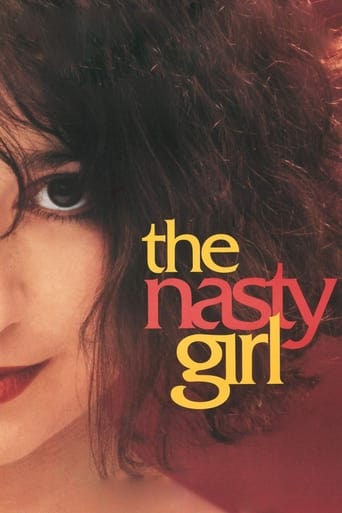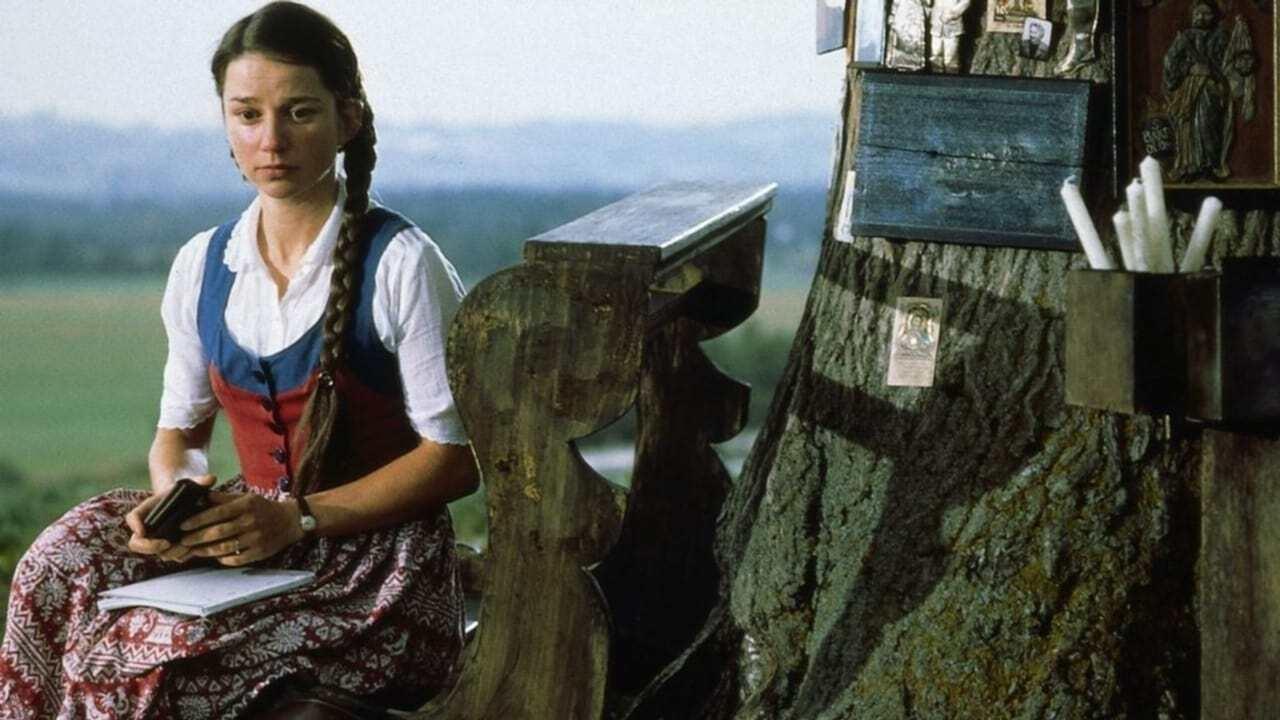Lee Eisenberg
Sonja (Lena Stolze) seems like any ordinary person. That is, until she has to research her town's history for a project. In the process, she discovers that her town was heavily involved in the Third Reich. Then, everyone in town not only turns against her, but tries in every possible way to silence her.Much like another West German film ("The Lost Honor of Katharina Blum"), "The Nasty Girl" shows a woman used as a scapegoat for something that was society's fault (it makes sense for German movies to deal with that; it's exactly what the Third Reich was all about). Another one of Germany's solid masterpieces.Watching this movie, I couldn't help but wonder what sorts of secrets any place, anywhere on Earth, carries.
gftbiloxi
German playwright Bertolt Brecht felt that theatre should teach the audience certain moral lessons, and to this end he developed a mode of presentation frequently described as "theatre of alienation"--a type of production in which the audience is never allowed to fully identify with the characters and their situations and is instead asked to critically observe the material and draw conclusions from it. For the most part, this is a style that works best on the stage--but director Michael Verhoeven uses it as a springboard for THE NASTY GIRL. And the result is one of the few instances in which these Brechtian concepts come successfully to the screen.The story is wickedly funny. A bright young lass, the daughter of two teachers, wins an essay contest--and when the next contest is announced she again decides to compete, this time with an essay on "My Hometown During The Third Reich," in which she plans to show how her small Bavarian town resisted Nazism. But few, even those regarded by the townfolk as heroes of that era, are willing to discuss it--and those that do provide conflicting information. She eventually gives up the project, but it continues to fester in the back of her mind, and some years later when she resumes her research with the idea of writing a book she discovers that the anti-Nazi heroes were not, perhaps, either anti-Nazi or heroic.The main thrust of the film centers upon Sonja's relentless battle against the powers that be to obtain access to documents from the Nazi era, and how civic leaders work to frustrate her--both by persistently dodging her demands for the material and by direct terrorism. But their resistance makes Sonja all the more determined, and she becomes willing to pay any personal price. Ultimately, she does arrive at some of the truth, only to discover that she has now been enshrined by civic leaders as a "hero" in an effort to silence her with praise.Director Michael Verhoeven presents the story in an odd mix of documentary and theatrical and realistic styles that mesh extremely well to create that famous Brechtian effect without ever actually seeming preachy. And leading actress Lena Stolze, as "the nasty girl" who accidentally drifts into the role of advocate for the truth at any price, is equally remarkable: she gives a very likable, bemused performance that draws the viewer in even while maintaining the necessary degree of detachment the style requires. Not all viewers will appreciate the film--some will find the subject too dark, others may not be able to buy into the style--but this is a brilliant film, and you owe it a chance. Strongly recommended.Gary F. Taylor, aka GFT, Amazon Reviewer
nightraven20
Using Brecht's idea of Epic Theatre, Michael Verhoeven creates a stage upon which audiences can learn from the past, and critique such instances from World War Two and Nazi Germany through the main character Sonja's struggles.
Brecht wanted Epic Theatre to use history and let audiences apply it to the present. This type of theatre makes you aware that you are watching something staged, so that you analyze the situation rather then feeling the same emotions of the characters. Verhoeven does this very nicely using a few alienation effects (also know as vefremdungs effekt). One scene taking the walls down of Sonja's living room and having it float through town while people anonymously call and threaten her family. Here the idea of Foucault's panoptican (an instrument that can see everything) comes into play as well. Sonya has no anonymity from the public, which is made up of the church, the government, the media, and the fifth establishment (the elder generation that serve as a link from the past to the present), yet she cannot identify any of them specifically. Later on again in a different sequence, Verhoeven brings back the walls. It is here that Sonja learns some names she can use to defend herself, and the walls of defense are back. Bringing back the walls also helps alarm the audience, just in case they were becoming too comfortable without them.Another part of the film is Sonja's family. In many scenes the children are seen crying and the father, Martin, tending to them and getting rather flustered. At one point he yells at Sonja telling her how her children would like their mother. Later on at the end of the film we learn that he has left her. Verhoeven plays on Sonja's obsession for finding the truth as a distraction from her family, yet there are parts where she still says she needs to stop, for the safety of her family because of threats. I think the scenes of neglecting the family are overdone to not show the point that Sonja is a bad mother, but that she wants her children to grow up and learn to love their Heimat (homeland), which during WWII was given a negative political term. She wants to make things better for her children so they don't grow up learning all of the corrupt things the her town has been covering up.The Nasty Girl is a clever and great cinematic film that makes you think, rather then feel. As the viewer you walk away learning something.
tanyamm223
Verhoeven incorporated Brechtian aesthetics in Das Schreckliche Madchen (The Nasty Girl) using dissociation devices. For example, Lena Stolze (playing Sonja) uses a form of acting class gestic. The actor doesn't completely embrace the role, rather resists and narrates it so you can tell the acting is false. Her acting helps us attain insights about stereotypical social relationships, which is an aim of epic theater. Sonja was quoting hyper romanticized behavior in order to make a point. Sonja's character critiques existing stereotypes of the roles women play in society. For example, by forcefully leaning her head on her husband's shoulder after marriage shows that it isn't a natural behavior. It is a symbol of romantic gesturing that we are taught to accept as natural. One can tell this action is produced and dramatized to allow the audience to think about women's roles in society. A woman putting her head on a male's shoulder implies she leans to her husband for support or guidance. This gesture implies women hold a passive and dependent role in society, where they look to the husband for support, and hold non-active roles in the outside community. For example, women are taught to cook and clean in order to be good housewives and to support a family. When a film is passed from one culture to another, it is not marketed as it would be in its original country. I think that American distributors view femaleness with little regards or respect by the way they market films. If they were to give more respect to the way femaleness is viewed, then they would have given this film the correct amount of accuracy it deserved. For instance, as `The Nasty Girl' passed from the German culture to the American culture, the way it was advertised did not represent the film in all actuality. First of all, the title gives a misleading impression. There is nothing nasty about Sonja's character. The title should have been translates into something like `The girl with courage' from having no support from her town in her quest to uncover the hidden truth about the town's involvement with the Nazis. Due to the misleading translation of the title, the film is often put in the adult section of the video store when there is nothing pornographic about the film's content. Also, the outside box cover is red, which symbolized promiscuity. Another example of how the film was marketed poorly in the US is the summary on the outside box cover. The summary says nothing about the historical content or even what it is about; instead it portrays something more promiscuous. This portrays how the American culture's primary concern is making a profit. The marketers of the film feel if they can get it to sound more enticing, more people will view the film. Apparently they will go to extremes such as misinforming the viewer about the content in the film in order to make the film seem more attractive to the viewers' eye. They take the audient for granted, and have no problem in exploiting the viewer's horizon of expectations.


 AD
AD
